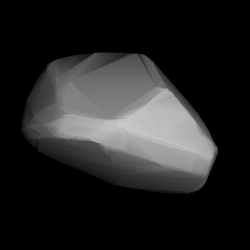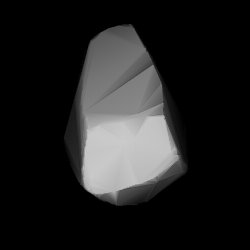Related Research Articles
2348 Michkovitch, provisional designation 1939 AA, is a presumed carbonaceous Erigone asteroid from the inner regions of the asteroid belt, approximately 15 kilometers in diameter. It was discovered by Serbian astronomer Milorad Protić at Belgrade Observatory on 10 January 1939. The asteroid was named after Serbian astronomer Vojislav Mišković.
2751 Campbell, provisional designation 1962 RP, is a stony Nysian asteroid from the inner regions of the asteroid belt, approximately 6 kilometers in diameter.
14335 Alexosipov, provisional designation 1981 RR3, is a stony Flora asteroid from the inner regions of the asteroid belt, approximately 4 kilometers in diameter. It was discovered by Soviet–Russian astronomer Nikolai Chernykh at the Crimean Astrophysical Observatory in Nauchnyj, on 3 September 1981. The asteroid was named after astronomer Alexandr Osipov.

3544 Borodino (prov. designation: 1977 RD4) is a stony background asteroid from the inner regions of the asteroid belt, approximately 9 kilometers (5.6 miles) in diameter. It was discovered on 7 September 1977, by Soviet astronomer Nikolai Chernykh at the Crimean Astrophysical Observatory in Nauchnij, on the Crimean peninsula. The likely elongated S-type asteroid has a rotation period of 5.44 hours. It was named for the Russian village of Borodino where the Battle of Borodino took place.

2490 Bussolini is an Eunomia asteroid from the central region of the asteroid belt, approximately 12 kilometers in diameter. It was discovered on 3 January 1976, by staff members of the Félix Aguilar Observatory at El Leoncito Complex in Argentina. The asteroid was named after Argentine Jesuit physicist Juan Bussolini.
29292 Conniewalker, provisional designation 1993 KZ1, is a bright, stony Phocaea asteroid and slow tumbler from the inner regions of the asteroid belt, approximately 4.6 kilometers in diameter. It was discovered on 24 May 1993, by American astronomer Carolyn Shoemaker and Canadian astronomer David Levy at the Palomar Observatory in California, United States.
1991 Darwin, provisional designation 1967 JL, is a stony Florian asteroid from the inner regions of the asteroid belt, approximately 5 kilometers in diameter.

1555 Dejan, provisional designation 1941 SA, is an asteroid from the background population of the central regions of the asteroid belt, approximately 22 kilometers in diameter. It was discovered on 15 September 1941, by Belgian astronomer Fernand Rigaux at the Royal Observatory of Belgium in Uccle. The asteroid was named after Dejan Đurković, son of Serbian astronomer Petar Đurković.

1335 Demoulina, provisional designation 1934 RE, is a stony Florian asteroid from the inner regions of the asteroid belt, approximately 7 kilometers in diameter. Discovered by Karl Reinmuth at Heidelberg Observatory in 1934, the asteroid was named after Prof. Demoulin, a Belgian astronomer at Ghent University. It has a slower-than average spin rate of nearly 75 hours.
1710 Gothard, provisional designation 1941 UF, is a stony asteroid from the inner regions of the asteroid belt, approximately 9 kilometers in diameter. It was discovered on 20 October 1941, by Hungarian astronomer György Kulin at the Konkoly Observatory in Budapest, Hungary. It was later named after Hungarian amateur astronomer Jenő Gothard.
1455 Mitchella, provisional designation 1937 LF, is a Florian asteroid, slow rotator and suspected tumbler from the inner regions of the asteroid belt, approximately 7 kilometers in diameter. It was discovered on 5 June 1937, by astronomer Alfred Bohrmann at the Heidelberg-Königstuhl State Observatory in southwest Germany. The asteroid was named after American astronomer Maria Mitchell.
2648 Owa, provisional designation 1980 VJ, is a background asteroid from the Flora region of the inner asteroid belt, approximately 6 kilometers in diameter. It was discovered on 8 November 1980, by American astronomer Edward Bowell at the Anderson Mesa Station near Flagstaff, Arizona, in the United States. The presumably S-type asteroid has a rotation period of 3.56 hours. It was named for the word "rock" in the Native American Hopi language.
2308 Schilt, provisional designation 1967 JM, is a stony Eunomia asteroid from the asteroid belt, approximately 17 kilometers in diameter. It was discovered on 6 May 1967, by Argentine astronomer Carlos Cesco together with American astronomer Arnold Klemola at the Yale–Columbia Southern Station at Leoncito Astronomical Complex in Argentina.
4789 Sprattia, provisional designation 1987 UU2, is a stony background asteroid from the inner regions of the asteroid belt, approximately 4 kilometers (2.5 miles) in diameter. It was discovered on 20 October 1987, by Canadian astronomer David Balam at the Climenhaga Observatory (657) in Victoria, Canada. The S-type asteroid has a rotation period of 3.1 hours and was named after Canadian amateur astronomer Christopher E. Spratt.
7776 Takeishi, provisional designation 1993 BF, is a background asteroid from the inner regions of the asteroid belt, approximately 6 kilometers in diameter. It was discovered on 20 January 1993, by Japanese astronomer Takeshi Urata at the Nihondaira Observatory in Japan. The assumed S-type asteroid has a rotation period of 8.9 hours. It was named after Japanese amateur astronomer Masanori Takeishi.
1530 Rantaseppä, provisional designation 1938 SG, is a stony Florian asteroid from the inner regions of the asteroid belt, approximately 5 kilometers in diameter. Discovered by Yrjö Väisälä at Turku Observatory in 1938, it was later named after Finnish astronomer Hilkka Rantaseppä-Helenius.
2195 Tengström, provisional designation 1941 SP1, is a stony Florian asteroid from the inner regions of the asteroid belt, approximately 8 kilometers in diameter. It was discovered on 27 September 1941, by Finnish astronomer Liisi Oterma at Turku Observatory in Southwest Finland, and named for Swedish geodesist Erik Tengström.
2011 Veteraniya, provisional designation 1970 QB1, is a stony Vestian asteroid from the inner regions of the asteroid belt, approximately 6 kilometers in diameter. It was discovered on 30 August 1970, by Russian astronomer Tamara Smirnova at the Crimean Astrophysical Observatory, Nauchnyj, on the Crimean peninsula, and named for the Soviet veterans of the Second World War.
10208 Germanicus, provisional designation 1997 QN1, is a stony Florian asteroid and binary system from the inner regions of the asteroid belt, approximately 3.5 kilometers in diameter.
12564 Ikeller, provisional designation 1998 SO49, is a stony Koronian asteroid from the outer region of the asteroid belt, approximately 5 kilometers in diameter.
References
- 1 2 3 4 "JPL Small-Body Database Browser: 1800 Aguilar (1950 RJ)" (2017-03-29 last obs.). Jet Propulsion Laboratory. Archived from the original on 20 December 2016. Retrieved 8 June 2017.
- 1 2 3 Schmadel, Lutz D. (2007). "(1800) Aguilar". Dictionary of Minor Planet Names – (1800) Aguilar. Springer Berlin Heidelberg. p. 144. doi:10.1007/978-3-540-29925-7_1801. ISBN 978-3-540-00238-3.
- 1 2 3 4 5 6 "LCDB Data for (1800) Aguilar". Asteroid Lightcurve Database (LCDB). Retrieved 19 December 2016.
- 1 2 3 4 Mainzer, A.; Grav, T.; Masiero, J.; Hand, E.; Bauer, J.; Tholen, D.; et al. (November 2011). "NEOWISE Studies of Spectrophotometrically Classified Asteroids: Preliminary Results". The Astrophysical Journal. 741 (2): 25. arXiv: 1109.6407 . Bibcode:2011ApJ...741...90M. doi:10.1088/0004-637X/741/2/90.
- 1 2 3 Masiero, Joseph R.; Mainzer, A. K.; Grav, T.; Bauer, J. M.; Cutri, R. M.; Dailey, J.; et al. (November 2011). "Main Belt Asteroids with WISE/NEOWISE. I. Preliminary Albedos and Diameters". The Astrophysical Journal. 741 (2): 20. arXiv: 1109.4096 . Bibcode:2011ApJ...741...68M. doi:10.1088/0004-637X/741/2/68 . Retrieved 19 December 2016.
- ↑ Veres, Peter; Jedicke, Robert; Fitzsimmons, Alan; Denneau, Larry; Granvik, Mikael; Bolin, Bryce; et al. (November 2015). "Absolute magnitudes and slope parameters for 250,000 asteroids observed by Pan-STARRS PS1 - Preliminary results". Icarus. 261: 34–47. arXiv: 1506.00762 . Bibcode:2015Icar..261...34V. doi:10.1016/j.icarus.2015.08.007 . Retrieved 19 December 2016.
- 1 2 "1800 Aguilar (1950 RJ)". Minor Planet Center. Retrieved 19 December 2016.
- ↑ Schmadel, Lutz D. "Appendix – Publication Dates of the MPCs". Dictionary of Minor Planet Names – Addendum to Fifth Edition (2006–2008). Springer Berlin Heidelberg. p. 221. doi:10.1007/978-3-642-01965-4. ISBN 978-3-642-01964-7.